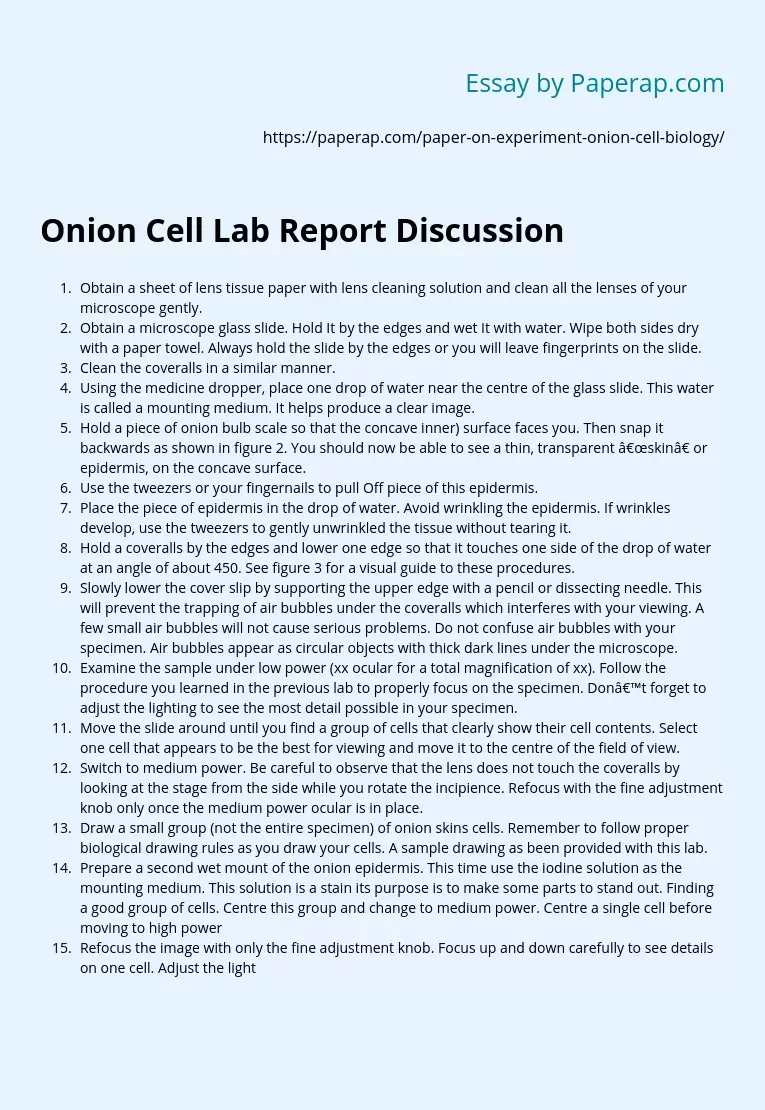Onion Cell Lab Report Discussion
- Obtain a sheet of lens tissue paper with lens cleaning solution and clean all the lenses of your microscope gently.
- Obtain a microscope glass slide. Hold It by the edges and wet It with water. Wipe both sides dry with a paper towel. Always hold the slide by the edges or you will leave fingerprints on the slide.
- Clean the coveralls in a similar manner.
- Using the medicine dropper, place one drop of water near the centre of the glass slide.
This water is called a mounting medium. It helps produce a clear image.
- Hold a piece of onion bulb scale so that the concave inner) surface faces you. Then snap it backwards as shown in figure 2. You should now be able to see a thin, transparent “skin” or epidermis, on the concave surface.
- Use the tweezers or your fingernails to pull Off piece of this epidermis.
- Place the piece of epidermis in the drop of water. Avoid wrinkling the epidermis.
If wrinkles develop, use the tweezers to gently unwrinkled the tissue without tearing it.
- Hold a coveralls by the edges and lower one edge so that it touches one side of the drop of water at an angle of about 450. See figure 3 for a visual guide to these procedures.
- Slowly lower the cover slip by supporting the upper edge with a pencil or dissecting needle. This will prevent the trapping of air bubbles under the coveralls which interferes with your viewing. A few small air bubbles will not cause serious problems.
Do not confuse air bubbles with your specimen. Air bubbles appear as circular objects with thick dark lines under the microscope.
- Examine the sample under low power (xx ocular for a total magnification of xx). Follow the procedure you learned in the previous lab to properly focus on the specimen. Don’t forget to adjust the lighting to see the most detail possible in your specimen.
- Move the slide around until you find a group of cells that clearly show their cell contents. Select one cell that appears to be the best for viewing and move it to the centre of the field of view.
- Switch to medium power. Be careful to observe that the lens does not touch the coveralls by looking at the stage from the side while you rotate the incipience. Refocus with the fine adjustment knob only once the medium power ocular is in place.
- Draw a small group (not the entire specimen) of onion skins cells. Remember to follow proper biological drawing rules as you draw your cells. A sample drawing as been provided with this lab.
- Prepare a second wet mount of the onion epidermis. This time use the iodine solution as the mounting medium. This solution is a stain its purpose is to make some parts to stand out. Finding a good group of cells. Centre this group and change to medium power. Centre a single cell before moving to high power
- Refocus the image with only the fine adjustment knob. Focus up and down carefully to see details on one cell. Adjust the lighting with the diaphragm control. Draw a single onion skin cell following proper biological drawing rules.
- Read the discussion questions and answer the questions as you work on your sketches.
- Clean and put away your microscope. Clean and put away the glass slides and coverall’s. Wash the counter tops off and make sure all the pieces of onion skin are placed in the garbage.
Discussion Questions
1. Describe the shape off single cell of an onion epidermis.
2. Describe the arrangement of the cells with respect to one another.
3. Describe the cytoplasm (cell fluid) off cell. Include color, clearness, and evidence of any motion. The outer edge of the cytoplasm is called the plasma membrane or cell membrane. It is difficult to see since it is normally pushed tightly against the cell wall.
4. Describe the nucleus off cell. If you saw them, include descriptions of the nuclear membrane, nucleolus’s, and nucleoli (there may be several). Are the nuclei always in the same position in the cell?
Why Is Iodine Stain Used On Onion Cells
5. Describe how the iodine stain that you used helped you see the cellular detail.
6. The empty spaces that you saw in the cytoplasm are called vacuoles. The contain mainly water and dissolved substances. Each vacuole is surrounded by part of the cytoplasm called a vacuole membrane.
7. You probably noticed that some cells had only one vacuole that filled most of the cell. Explain why the nucleus in those cells was so close to the cell wall. The droplets in the cytoplasm are the oil that gives onions their smell and make your eyes run. Describe an oil droplet.
8. Estimate the length of a single cell in micrometers (pm) using the method described in class. Use the diameter of the field of view for your objective used before making your calculations.
9. Label all the parts off cell that you can see such as the cell wall, nucleus, cytoplasm, cell membrane, nuclear membrane, nucleolus, nucleolus’s, vacuole, vacuole membrane, oil droplet. Make sure you follow proper labeling rules check the exemplar provided to be sure.
Onion Cell Lab Report Discussion. (2019, Dec 05). Retrieved from https://paperap.com/paper-on-experiment-onion-cell-biology/

